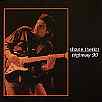Many times I've had students ask, "how should I practice?" or, "where do I start"? With the huge amounts of material available these days (videos, books, schools, Internet, etc.) it can certainly be overwhelming when trying to design a practice schedule. The following ideas have worked wonders for many players, myself included.
First off, lets define practicing. When you practice, you should set out to accomplish some sort of goal for yourself. This doesn't have to be a big deal, but practicing doesn't mean playing the same licks and jamming for hours. Practicing effectively involves working on things you don't already know and applying the information in order to reach another level.
Start out with some kind of schedule for yourself. You don't have to make it really elaborate and complicated, just a general idea of the material/music you want to cover. A little pre planning will go a long way and keep you focused, making the most of your time.
You should try and cover the basics - chords and rhythm (this might be a few new voicings, funk chord move, jazz bassline or a Curtis Mayfield tune), technique (picking exercises, Yngwie arpeggio sequence, Bach violin etudes, etc.), scales and arpeggios (lots of books and videos on these), and ear training (traditional ear training exercises or transcribing solos). If you get really ambitious you might add sight reading to this list. These would be a good start. As you can see, lots of material can fall into these categories. Don't forget improvising and composing. You should try to do a little of both each day.
Here is where things get interesting. When I attended GIT, we were told to use a timer set for 15-minute segments while practicing. The reason behind this concept is that the average attention span of a person is about 20 minutes. (It may be more for some and less for others...) It is during this period of time when your peak learning period takes place. You are apt to remember and retain more material learned during the first 15-20 minutes than the later segments. How do we apply this to practicing? We divide each of our subjects into 20 minute segments. (You will probably want to plan more time for transcribing and sight-reading, if you choose to.)
I realize that, but you will be amazed at how much you can learn using this method. Let's say you want to learn 3 positions of the melodic minor scale. The traditional way would be to hammer them all out at once, repeating all three patterns again and again. With this method, you are likely to confuse and mix up the scales. (They are weird patterns anyway). Using the 20 minute method, we work on one position, or even three strings at a time. By focusing on "bite size" portions of material for smaller increments of time, we can dramatically improve our retention. You can go back later in the day and hit them again if you like, but be sure to move on to another subject when the 20 minutes are up. For Chords and rhythm, you might work on a new group of voicings or a jazz standard. Again, try to break the material up into bite size pieces. Maybe only tackle the first 2 lines of the tune, then move on until later. This is effective practicing.
5 Min. Warm up (picking exercises and legato exercises)
20 Min. John Scofield solo from video (learn 3 lines) (Transcribing)
20 Min. Learn maj. 9 arpeggios (scales and arps)
20 Min. 3 new voicings from Eric Johnson book, compose tune with them
(chords and rhythm)
20 Min. Tape min7 progression and solo over it using Scott Henderson's applications for pentatonic scales (from video) (improvisation and scales)
5 Min. Short break
15 Min. Holdsworth legato exercise - 4 note per string scales (technique)
20 Min. Chet Atkins finger picking example (technique, chords and rhythm)
30 Min. Sight reading examples from Berklee text (sight reading)
In a little over 2 hours, you have built a schedule that will greatly enhance your practice time. This isn't dabbling; it's focusing. Try it for a few weeks and see how effective this can be.
Good luck with these concepts and try to keep an open mind; these are only suggestions that I have found helpful! You might want to check out Kenny Werner's excellent book, "Effective Mastery" for more ideas.
Shane Theriot is a guitarist dividing his time between New Orleans and Nashville who has played and/or toured with the Neville Brothers, Adam Nitti and Dave Weckl. He also does clinics for the Hamer guitar company.
His debut solo CD is entitled "Highway 90", an original mix of fusion, New Orleans second line and jazz/rock grooves beneath burning guitar lines.
